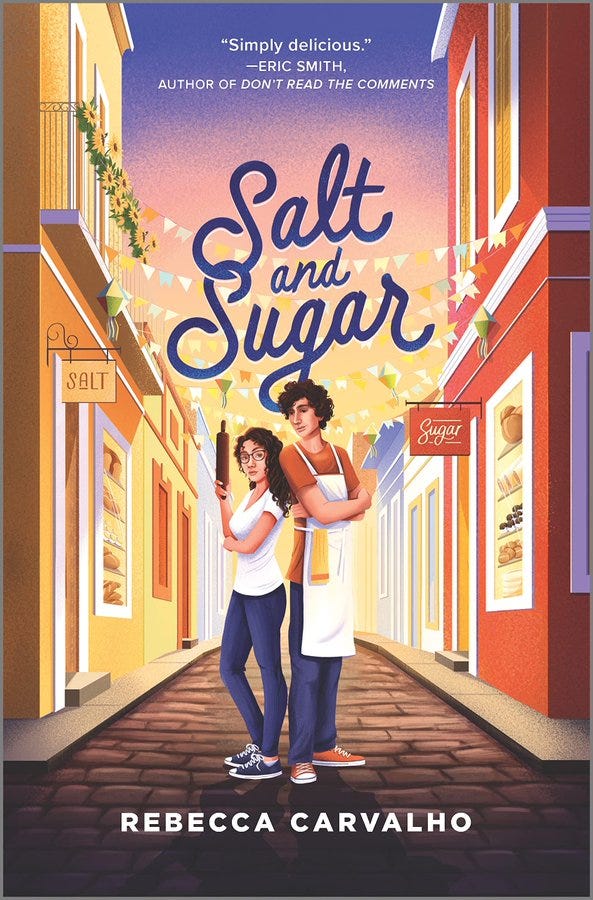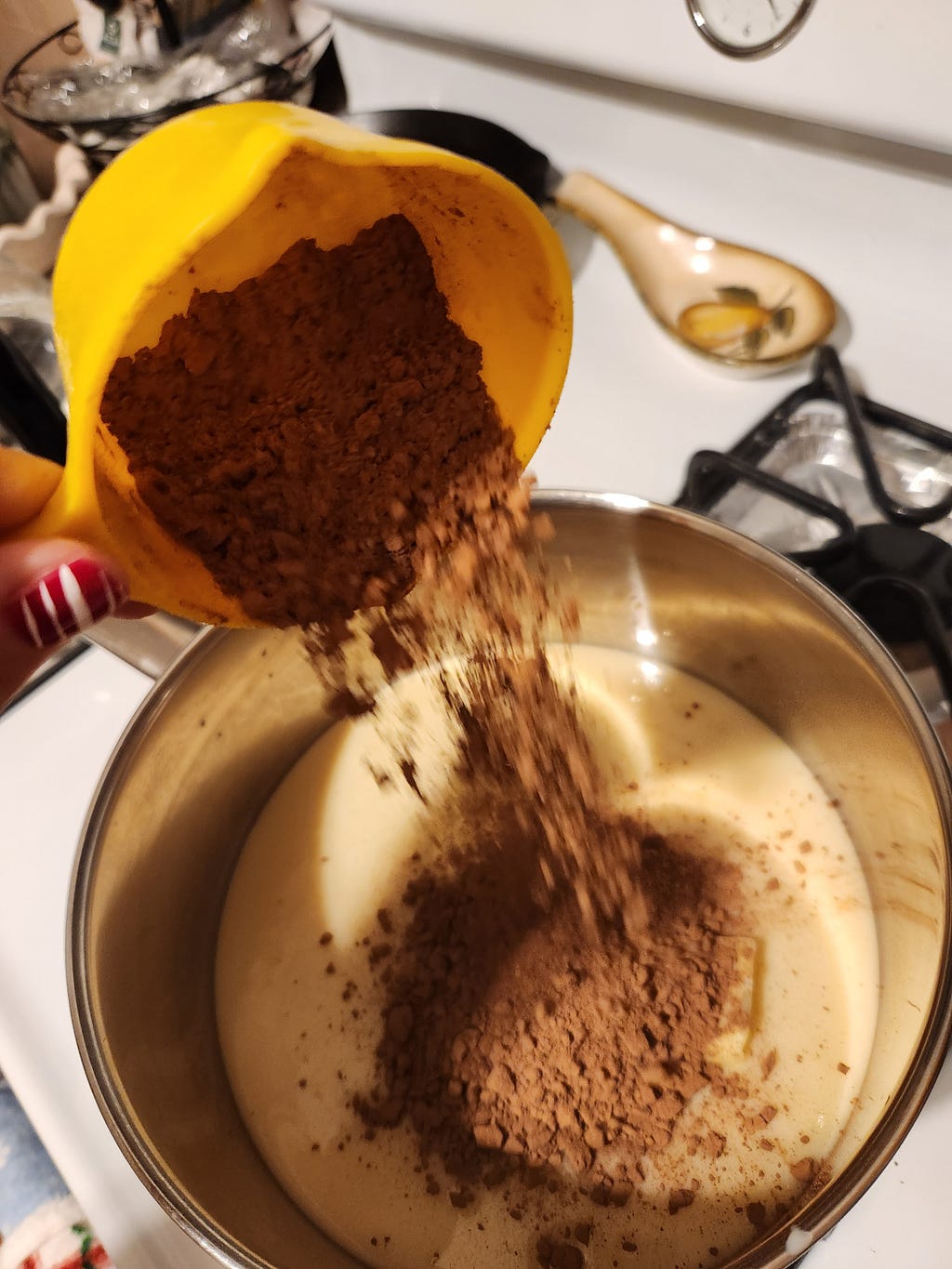Simmering Sweetness to Savor, Finding Love In & Beyond Romance: A Review of Rebecca Carvalho’s Salt and Sugar

Nothing is happening. These words echoed in my head during the first twenty arduous minutes of stirring the pot of condensed milk, butter, and cocoa powder, waiting for this mixture to turn into the dessert I had loved eating at birthday parties as a child. And then, like falling in love — the slightest shift. That’s when the magic begins, when this concoction starts to turn into the gooey, decadent sweetness that become the Brazilian chocolate-caramel truffles known as brigadeiros.
It is no accident that this rich recipe is one of the first that Salt and Sugar’s kitchen-clumsy but determined protagonist, Larissa Ramires, tackles — and spectacularly fails at — in the Cooking Club she has been assigned to by her teacher, a club run by her nemesis. Because of course it is. The romance between Lari and the enemy of her family’s rival bakery, Pedro Molinas, simmers the way brigadeiros do, slow and deliberate. Yes, you will wait hundreds of pages for these two to realize the extent of their feelings for each other and yes, it will be delicious. When you make brigadeiros, one feels the impulse to speed things up by turning up the heat, but author Rebecca Carvalho demonstrates the same restraint as an expert baker in building up an incredibly satisfying romance between these two characters in her debut novel.
I do not read romance novels looking to find myself — an ace-aro spectrum person — represented. Yet, I saw myself in Lari Ramires. I saw myself in her hesitations at a romance that started off as love-at-first-sight with handsome clubmate Victor. And I saw myself in how her long-standing relationship with Pedro, a friendship of shared values cloaked as rivalry, was what she needed first to truly fall in love at all. I do not know if Carvalho intended to write Lari as demiromantic; I do know that as someone who is demiromantic, this was the closest I have ever seen this identity represented and wow, what an unexpected treat!
Perhaps it’s because the romance, while an incredibly compelling will-they-won’t-they enemies-to-lovers slow burn that will tick a lot of boxes for any reader looking for those tropes, is not the true heart of the novel. Its heart is community. Its heart is absence and grief, as Lari experiences with the loss of her grandmother, Julieta, whose presence lit up the family bakery, Salt, and that of her father who died before she was born. Then, in the face of this grief, there is also the added challenge of Lari trying to find her own path against the heavy expectations that her well-intentioned mother Alice has placed on her. Alice is not a one-dimensional overbearing mother, but instead, a character whose motivations are deeply developed and whose own longing for dreams deferred instructs her interactions with Lari. Eldest and only daughters in immigrant families, tell me if this moment between Lari and her mother resonates with you, as Alice says to her daughter:
“You’re your father’s daughter. A talent like his, like yours, is a great asset to any school. This university is lucky to have you. You’ll be the first in Ramires to go to college.”
[Lari as narrator] Sometimes I feel like that’s all we have left. These college plans she wants me to fulfill. The milestone in our family. Without it, I worry there’s nothing left that ties us together.
Multiple love stories co-exist in this novel and I personally love that the romance between Lari and Pedro is just one of them. It is not given more importance than the love story between Alice and Lari, as the two begin that painful but necessary process in healthy adult parent-child relationships: they learn to see each other not merely as mother and daughter but as two separate human beings with dreams of their own. As mother and daughter alike grow to accept each other, we also see unfold the great love story of this novel, between Lari and her baking. Like her love with Pedro, it is also forbidden. In finding her way back to her love of baking, a love inherited from her late grandmother, she is able to find a deep abiding love for herself, no less important than the romantic love she finds with Pedro.
Lari’s decision to embrace her true love — baking! — reveals yet another love, that of her mother’s unconditional love for her. A less skillful author than Carvalho could have fudged this realization by making it a neatly tied bow à la Hallmark. It is instead a testament to Carvalho’s thoughtfulness in creating these character dynamics that the forgiveness and acceptance that occur between mother and daughter feels hard-earned and again, deeply satisfying. In accepting her daughter as she is, Alice learns to pursue her own abandoned dreams and thus, to stop using her child as a fulfillment of her own failed hopes. While I think this story could resonate with many diverse readers, immigrant daughters in particular, this novel is going to make you cry and you will love it.
The heart of the novel is about how to fight for the places you care about in the face of existential threats in the form of major corporations hellbent on turning the neighborhood you grew up in and love into a gentrified shell of itself. Growing up in Newark’s immigrant community of the Ironbound and watching its rising rents price out my own family, I deeply connected to the close-knit neighborhood of Olinda of northeastern Brazil where Carvalho, a Brazilian first-generation immigrant herself, set her story.
This is a novel about a neighborhood that fights back and two young bakers who fall in love in spite of their family’s longstanding feud, because they recognize the power of a community uniting against corporate greed. Pedro’s words to Lari as they strike up a truce to save their respective bakeries speak to this: “I have to do this for my family [. . . .] You’re fighting for your home, too. You’re the only one who understands the way I feel now.” These are not the words of a starry-eyed lover; this is a deliberate vow to protect family and community against everything that would undo it. And in uniting against the common enemy — late-stage capitalism in the form of a mega-corporation — Lari and Pedro learn to turn their feud into friendship and from there, into romance.
In hearing the initial premise of Salt and Sugar, you might be tempted to think this is just another spinoff of Romeo and Juliet — and yes, indeed, Lari and Pedro do, through yet another clumsy/adorable kitchen accident, combine a mixture of guava and cheese desserts which creates their own spinoff of a common Brazilian dessert, Romeu e Julieta. However, this differs in key ways from the source material. Firstly, neither of the lovers are shallow narcissists. Importantly, they find a way to bring their families and community together because their romantic love is not the central focus of their lives to the detriment of everyone else around them. While both Pedro and Lari have a temper and can act rashly, their work at repair — of the relationships within and between the feuding families — is deliberate and thoughtful. What brings these two rival chefs together is their shared commitment to their families and the community they love; in this abiding love, they grow — slowly and not without mistakes, like a simmering brigadeiro mixture — to love one another.
If you are looking for a steamy romance novel, this is not your book. This book is for anyone who finds freedom and joy and beauty in baking — in getting your hands in the dough and making mistakes. This book is for anyone who knows what it is like to desperately wish you could want to fulfill the dreams your parents have for you, dreams they have sacrificed for. This book is for anyone brave enough to follow their own path anyway. This book is for anyone who has never experienced love at first sight, who needs a deep meaningful connection with another person before experiencing romantic attraction, even when that connection might come disguised as hatred. This book is for daughters learning to accept their mothers as they are and discovering that their mothers might love them as they are, imperfectly and lovable all the same. This book is for anyone who knows what it is like to love a community under threat of extinction. This book is for those who act like Lari’s grandmother Julieta — wandering their own hometown like “a tourist, pointing out every detail that caught her eye, every little thing that made her smile.” When Lari questions this, her grandmother responds “that it was important to fall in love with one’s neighborhood over and over again.” This book is for the people who fight back.

Above photo: making brigadeiros, a glorious treat!
Salt and Sugar by Rebecca Carvalho
Inkyard Press via HarperCollins Publishers (November 2022) — 400 pages, $18.99
Simmering Sweetness to Savor: A Review of Rebecca Carvalho’s Salt and Sugar was originally published in ANMLY on Medium, where people are continuing the conversation by highlighting and responding to this story.
